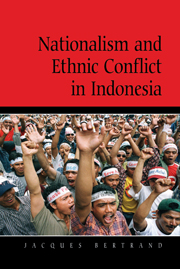Book contents
- Frontmatter
- Contents
- List of figures and tables
- Preface
- Maps
- 1 Introduction
- 2 Critical junctures, nationalism, and ethnic violence
- 3 The national model and its institutional history
- 4 Exclusion, marginality, and the nation
- 5 Islam and nation: The Muslim–Christian dimension
- 6 The escalation of religious conflict
- 7 Conflict in Maluku
- 8 Late integration into the nation: East Timor and Irian Jaya (Papua)
- 9 Aceh's ethnonationalist conflict
- 10 Autonomy as a solution to ethnic conflict
- 11 Unity in diversity
- Notes
- Glossary
- Bibliography
- Index
- CAMBRIDGE ASIA–PACIFIC STUDIES
4 - Exclusion, marginality, and the nation
Published online by Cambridge University Press: 10 December 2009
- Frontmatter
- Contents
- List of figures and tables
- Preface
- Maps
- 1 Introduction
- 2 Critical junctures, nationalism, and ethnic violence
- 3 The national model and its institutional history
- 4 Exclusion, marginality, and the nation
- 5 Islam and nation: The Muslim–Christian dimension
- 6 The escalation of religious conflict
- 7 Conflict in Maluku
- 8 Late integration into the nation: East Timor and Irian Jaya (Papua)
- 9 Aceh's ethnonationalist conflict
- 10 Autonomy as a solution to ethnic conflict
- 11 Unity in diversity
- Notes
- Glossary
- Bibliography
- Index
- CAMBRIDGE ASIA–PACIFIC STUDIES
Summary
Indonesia's national model created categories of excluded and marginalized groups. Although it was based on a civic concept, namely that citizenship should be granted to all people living in the former Dutch East Indies, its expression in legislation excluded or marginalized certain groups. A process of differentiation set them apart from the state's construction of “Indonesian-ness.”
During the third critical juncture that accompanied the end of the New Order regime, some of these groups were participants in or victims of ethnic violence. The marginalized Dayaks fought Madurese migrants on the island of Kalimantan in 1996, 1999, and 2001. Chinese Indonesians were targeted during a wave of small-scale riots between 1996 and 1998. They were also victims during the bloody riots of May 1998 that formally ended the New Order regime of President Suharto. Marginalization and exclusion differentiated the Dayaks and the Chinese from other Indonesians. They provided a basis for discrimination that partly explains their involvement in ethnic violence during the period of institutional transition in the late 1990s.
The marginalized included a large number of groups that were considered “tribal” or “isolated” communities. Typically, they lived in hinterlands or mountain areas, thereby geographically distant from urban centers and from the reach of the state. They were treated as second-class citizens, as “primitive” or “backward” groups that lacked the “modern” characteristics of “Indonesian” citizens.
In a separate category, the “non-pribumi” were excluded from all other Indonesians because they were considered non-indigenous. Chinese Indonesians were the only group in this category.
- Type
- Chapter
- Information
- Nationalism and Ethnic Conflict in Indonesia , pp. 45 - 71Publisher: Cambridge University PressPrint publication year: 2003



